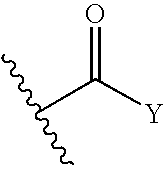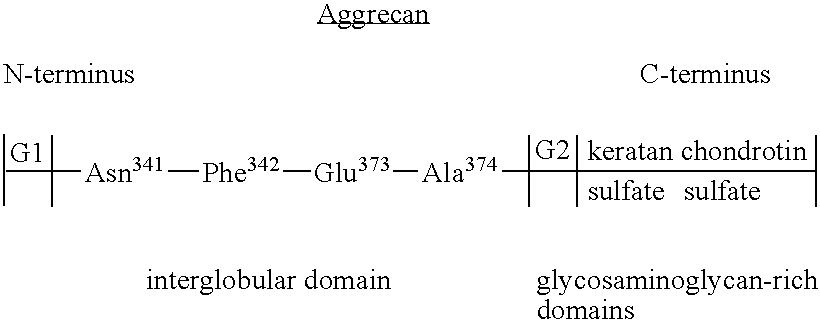Selective inhibition of aggrecanase in osteoarthritis treatment
a technology of aggrecanase and osteoarthritis, which is applied in the direction of metabolism disorder, extracellular fluid disorder, immune disorders, etc., can solve the problems of limited symptomatic benefit of current osteoarthritis therapies, blockage or slowing the progression of osteoarthritis, and only modest, if any, effects on slowing cartilage destruction and osteoarthritis progression, etc., to achieve greater metabolic stability, increase in vivo half-life, and facilitate preparation and delectability
- Summary
- Abstract
- Description
- Claims
- Application Information
AI Technical Summary
Benefits of technology
Problems solved by technology
Method used
Image
Examples
example 1
Preparation of a Compound of Formula I, Wherein X is Carbon, R3, R4, R7, and R8 are Each Hydrogen, and R1, R2, R5, and R6 are as Above, According to General Scheme 1
Example of a Preparation of a Compound of Formula III, Step 1, Scheme 1 (2-Hydroxy-1-hydroxymethyl-2-methyl-but-3-enyl)-carbamic acid tert-butyl ester
[0309]To a solution of 4-(1-hydroxy-1-methyl-allyl)-2,2-dimethyl-oxazolidine-3-carboxylic acid tert-butyl ester (compound of formula II, 3.3 g, 12.1 mmol, prepared as in Ageno, G.; Banfi, L.; Cascio, G.; Guanti, G.; Manghisi, E.; Riva, R.; Rocca, V. Tetrahedron, 1995, 29, 8121) in 100 ml of methanol was added p-toluenesulfonic acid monohydrate (0.215 g, 1.1 mmol). After stirring for about 30 minutes at a temperature of about 20° C. to about 25° C., the mixture was diluted with saturated aqueous sodium bicarbonate and was concentrated in vacuo. The residue was diluted with water and was extracted 3 times into ethyl acetate. The combined organic layers were dried over sodium ...
example 2
Preparation of a Compound of Formula I, According to General Scheme 2, Wherein X is Carbon, R3, R4, R7, and R8 are Hydrogen, R1 is Hydroxy, and R2, R5, and R6 are as Above
Example of a Preparation of a Compound of Formula XV, Step 13, Scheme 2 [4-Benzyloxybenzenesulfonylamino]-acetic acid tert-butyl ester
[0327]To a mixture of glycine tert butyl ester hydrochloride salt (compound of formula XIV, 50 g, 300 mmol) and dimethylformamide (400 ml) at about 0° C. was added triethylamine (127 ml, 885 mmol) and 4-benzyloxybenzenesulfonyl chloride (102 g, 357 mmol). After stirring for about 1 hour, the mixture was warmed to a temperature of about 20° C. to about 25° C., and stirred for about an additional 12 hours. The mixture was diluted with 1M hydrochloric acid, extracted twice with ethyl acetate, and the combined organic layers were dried over sodium sulfate, filtered and concentrated in vacuo. Trituration of the residue with ether-hexane afforded 91 g of [4-Benzyloxybenzenesulfonylamino]-a...
example 3
Preparation of a Compound of Formula I, According to General Scheme 4, Wherein X is Carbon; R3, R7, and R8 are Hydrogen; R1 and R2 are Methyl; R4 is Hydroxy; and R5 and R6 are as Above
Example of a Preparation of a Compound of Formula XXXII, Step 28, Scheme 4 (2R)-3,3-Dimethyl-2-(1-(R)phenyl-ethylamino)-hex-5-enenitrile
[0335]To a solution of R-α-methylbenzylamine hydrochloride (14 g, 89 mmol) and potassium cyanide (5.8 g, 89 mmol) in 90 ml of methanol at about 0° C. was added a solution of 2,2-dimethyl-4-pentenal (compound of formula XXXI, 10 g, 89 mmol) in 10 ml of methanol. The resultant mixture was warmed to a temperature of about 20° C. to about 25° C. and was stirred for about 48 hours. The mixture was filtered, and the filtrate was concentrated in vacuo. Crystallization from 3:1 methanol-water afforded 10.7 g of R,R-3,3-dimethyl-2-(1-phenyl-ethylamino)-hex-5-enenitrile (compound of formula XXXII) as a colorless solid.
Example of a Preparation of a Compound of Formula XXXIII, Ste...
PUM
| Property | Measurement | Unit |
|---|---|---|
| temperature | aaaaa | aaaaa |
| temperature | aaaaa | aaaaa |
| temperature | aaaaa | aaaaa |
Abstract
Description
Claims
Application Information
 Login to View More
Login to View More - R&D
- Intellectual Property
- Life Sciences
- Materials
- Tech Scout
- Unparalleled Data Quality
- Higher Quality Content
- 60% Fewer Hallucinations
Browse by: Latest US Patents, China's latest patents, Technical Efficacy Thesaurus, Application Domain, Technology Topic, Popular Technical Reports.
© 2025 PatSnap. All rights reserved.Legal|Privacy policy|Modern Slavery Act Transparency Statement|Sitemap|About US| Contact US: help@patsnap.com



